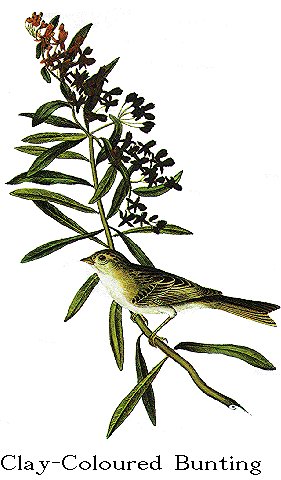
| Family XV. FRINGILLINAE. FINCHES. GENUS II. EMBERIZA, Linn. BUNTING. |
Next >> |

Family |
CLAY-COLOURED BUNTING. [Clay-colored Sparrow.] |
| Genus | EMBERIZA PALLIDA, Swains. [Spizella pallida.] |
This homely looking little bird was discovered by Dr. RICHARDSON, who
states that it "visits the Saskatchewan in considerable numbers, frequents the
farm-yard at Carlton House, and is as familiar and confident as the common
House-Sparrow of England." My friend Mr. NUTTALL, in speaking of it as allied
to Fringilla pusilla of WILSON, states that it is distinct in its habits, it
being a prairie bird, not seen in the woods, and occurring only in spring,
although in all other points it agrees with the species just mentioned. It was
not met with by him far up the Platte, but is supposed to visit the prairies of
the Missouri down to the line of settlements. My drawing represents a male. A
female in my possession differs only in being rather smaller.
Platte river, Missouri plains, and Fur Countries. Common. Migratory.
EMBERIZA PALLIDA, Clay-coloured Bunting, Swains. and Rich. F. Bor. Amer.,vol. ii. p. 251.
CLAY-COLOURED BUNTING, Emberiza pallida, Aud. Orn. Biog., vol. v. p. 66.
Adult Male.
Bill short, strong, conical, compressed toward the end, acute; upper
mandible rather broader than the lower at the base, but less deep beyond the
nostrils, its dorsal line declinate and slightly convex, the sides convex, the
edges, direct, the gape-line ascending to beyond the nostrils, afterwards
straight, the tip acute; lower mandible with the angle short and rounded, the
dorsal line almost straight, the sides rounded; the edges inflected, the tip
acute. Nostrils basal, roundish, partially concealed by the feathers.
Head ovate, of moderate size; neck short; body rather slender. Feet of
moderate length, slender; tarsus compressed, with seven anterior scutella, and
two plates behind, meeting so as to form a sharp edge; toes free, the first
stronger, the third much longer than the lateral, of which the inner is somewhat
shorter than the outer; claws of moderate length, arched, much compressed,
laterally grooved, acute.
Plumage soft and blended, on the back rather compact. Wings of moderate
length, rather rounded, the first quill two-twelfths of an inch shorter than the
second, which is scarcely longer than the third and fourth the other primaries
slowly graduated; the secondaries rounded, the inner not elongated. Tail long,
emarginate, of twelve narrow feathers, of which the middle are three-twelfths of
an inch shorter than the outer.
Bill yellow, greyish-brown toward the end. Feet flesh-coloured, claws
dusky brown. The general colour of the upper parts is light yellowish-brown,
each feather having a central streak of brownish-black; the streaks on the rump
are fainter and more slender. The quills and tail feathers greyish-brown,
narrowly margined with brownish-white. Over the eye is a long band of
brownish-white; the cheeks are pale brown, the sides of the neck are very light
buff, the rest of the lower parts greyish-white, the sides of the body tinged
with greyish-brown.
Length to end of tail 5 2/12 inches; bill along the ridge 4 (4 3/4)/12;
wing from flexure 2 7/12; tail 2 8/12; tarsus (8 1/2)/12; hind toe (3 1/4)/12,
its claw 3/12; middle toe (5 1/2)/12, its claw (2 1/2)/12.
The Female is similar to the male, but has less yellow on the sides of the
neck, and is somewhat smaller.
Length to end of tail 5 2/12 inches; bill along the ridge (4 1/2)/12; wing
from flexure 2 (7 1/2)/12; tail 2 6/12; tarsus 8/12; hind toe and claw 6/12;
middle toe and claw 8/12.
This species has some resemblance to Emberiza pusilla, from which, however,
it is easily distinguishable. The bill is longer and much more slender, its
wings and tail also longer, and the latter more deeply emarginate. There are
none of the reddish-brown tints conspicuous in the Field Sparrow, which,
moreover, has the gape-line less deflected at the base, and has the palate
concave, in place of being knobbed. The specimens from which the above
descriptions have been taken, were procured on the 15th of June, 1834, on the
Rocky Mountains, by Mr. TOWNSEND.
| Next >> |